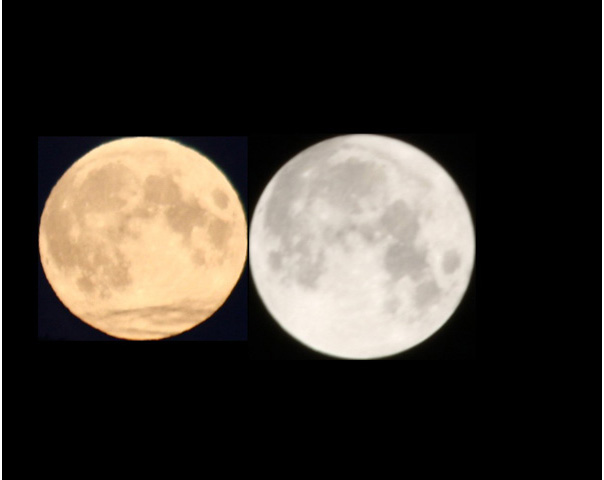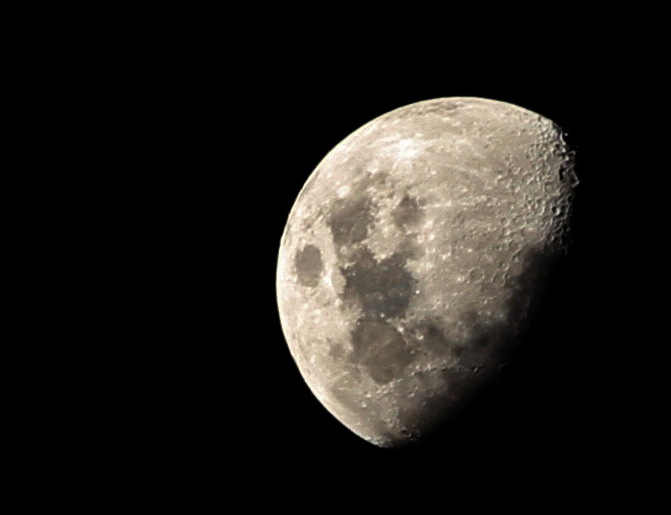 This puzzle dates back to ancient times. Remarkably, it remains unsolved. I am referring to the perceived phenomenon that the moon appears larger when just above the horizon than it does when high in the sky. I'm sure you have noticed this effect. Of course, the moon does not change in size, but why does it appear larger near the horizon? Like Aristotle, who had the same idea a bit earlier, I used to think it was a fishbowl effect, due to viewing the moon through more of the earth's atmosphere. After a bit of research I discovered that:
This puzzle dates back to ancient times. Remarkably, it remains unsolved. I am referring to the perceived phenomenon that the moon appears larger when just above the horizon than it does when high in the sky. I'm sure you have noticed this effect. Of course, the moon does not change in size, but why does it appear larger near the horizon? Like Aristotle, who had the same idea a bit earlier, I used to think it was a fishbowl effect, due to viewing the moon through more of the earth's atmosphere. After a bit of research I discovered that:
(1) this explanation was discredited about a thousand years ago
(2) the moon's angular diameter is not larger when near the horizon. It is actually 1.5% smaller!
(3) the illusion is unexplained.
Being unconvinced, I decided to check for myself. I took a photo in Sydney of the moon on 28.4.10 when it was about 75 degrees above the horizon using my 300 mm lens. In Norway I snapped the moon just above the horizon using the same lens setting on 26.7.10. The image at right is a composite of these two photographs, with one image inverted for ease of comparison.
The white moon image is about 10% wider than the coloured one. More remarkable is the fact that the white image is of the moon high in the sky and the coloured one is near the horizon, which is the opposite of what I expected.
A note on scientific method: had it been the other way around, ie the low viewpoint image being larger than the high one, I would have concluded that wikipedia was wrong and my fishbowl theory right. Seeing it's the other way around, I admit my theory is wrong, and that I can't explain the illusion. Worse yet, I can't explain why I get a size difference of 10% instead of the stated 1.5%. My point is that we don't question data that confirms our beliefs.
Yet another quirk: why do the features of the moon look so different in the two shots (I don't mean the colour)? Surely, the moon should look the same from Sydney and Norway?
Someone pointed out that atmospheric refraction has an effect. It does, but in the wrong direction, making the moon appear smaller. The same person pointed out that taking photos at different times and places is not a good way to investigate the question. That is true.
I am a huge fan of wikipedia. It is the first place I look for information. One of the great things about wikipedia is that it contains articles that are not likely to appear in a conventional encyclopedia, such as the moon illusion. This article mentions that the moon changes in apparent size by up to 10% due to being at its closest and furthest points from the earth. That might explain my result.
A short digression
I was re-reading a chapter of one of Oliver Sacks' books, on colour vision, and could not follow the explanation. I quickly found this very interesting article on colour constancy and the fascinating retinex theory.
You can easily demonstrate colour constancy for yourself. Put fruit of different colours inside one of those green cloth shopping bags. Take it into bright sunlight and make sure that you view the fruit inside the bag using the green light that passes through the material. You will see that a red apple still looks red, a banana still looks yellow etc. Yet your eye is not seeing the same colours as when the fruit was outside the bag. Why do you still see much the same colours? It's due to a brain mechanism that ensures that objects appear similar to us regardless of the lighting.
The naive view of colour perception is that the frequency of the light striking our retinas determines the colour that we see. This view is only partially correct. The colour we see is related to the wavelength of light, but not in a simple fashion. The key to the question is the maintenance of perceptual constancy, which includes colour constancy and much else. All three articles are well worth reading if you have any interest in the subject of perception.
What about the moon illusion then?
Driving to squash one Friday I had a eureka moment. It suddenly occurred to me that the cause of the moon illusion is due to a failure of our perceptual constancy system. Here is my theory, which is probably similar to the apparent distance hypothesis mentioned only in passing in the wikipedia moon illusion page.
The maintenance of perceptual constancy ensures that things are perceived (but not seen) to be the same size when viewed at different distances. Hence as we approach something we do not think it is actually getting bigger, though the image on our retina gets larger. This illustrates the difference between sensation and perception. Sensation is the data given by our senses, perception is the shape of that data after our neural system processes it. When we see an object, such as a chair, this is a perception, not a sensation. All our notions of the world derive from our perceptions. In particular, every illusion is due to a faulty perception.
It occurred to me that our perceptual constancy system is accustomed to judging the greater distance of birds or clouds seen near the horizon, as compared to the same birds or clouds seen above us, where the actual altitude is similar in both cases. So our brain must be aware that the clouds near the horizon are further away and hence will compensate for this, making them appear larger. In the case of the moon, there is not much difference in distance, whether the moon is high or low in the sky. This is because the moon is not at a set height within the earth's atmosphere, but is far beyond it. Not knowing this, our perceptual system makes the moon appear bigger near the horizon, on analogy with how it treats birds and clouds. In other words, it is the failure of our perceptual constancy system when dealing with astronomical objects that creates the illusion.
If you think about it, perceptual constancy is a vital skill from the point of view of survival. It is essential that we recognise a dangerous predator, such as a bear, whether we see it front-on against the sun, or from the rear at dusk. It is obviously essential for survival that we do not perceive a bear on the horizon as being tiny and hence harmless. Likewise, we need to distinguish edible from poisonous plants regardless of lighting conditions. Since we are not likely to accidentally hit the moon, the illusion of greater size has no evolutionary drawbacks.
Jason Rampe recommends this simple procedure to deflate the moon: put your hand up to block the horizon when the moon is just above it and watch as the moon suddenly shrinks to the normal size you are used to seeing.
